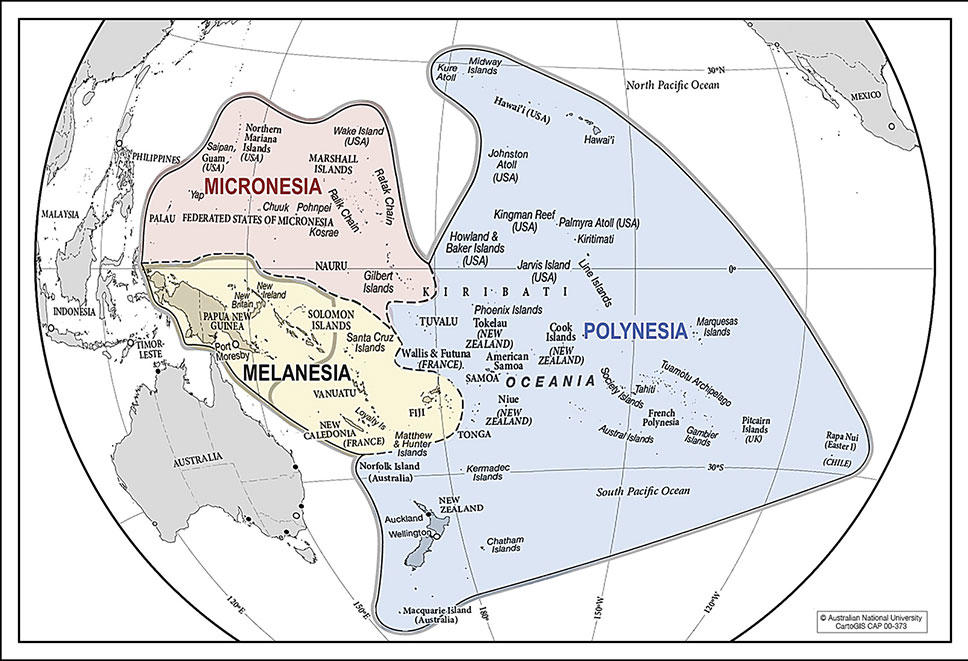Health Equity for Native Hawaiian and Pacific Islander Populations
, by Jacqueline B. Vo (REB) and Jaimie Z. Shing (IIB)
Since 1997, the Office of Management and Budget (OMB) has standardized five racial categories: 1) White, 2) Black or African American, 3) American Indian or Alaska Native, 4) Asian, and 5) Native Hawaiian or Other Pacific Islander1. This mandate appropriately separates “Asian and Pacific Islander” populations into two distinct racial groups: 1) Asian individuals, who represent ethnogeographic regions in Asia and 2) Native Hawaiian and Pacific Islander (NHPI) individuals, who represent ethnogeographic regions in Oceania (Melanesia, Micronesia, and Polynesia) (Figure 1)2. Importantly, the continued use of a combined Asian and Pacific Islander racial category can mask underlying disparities in cancer rates3-4, in part because there are fewer Native Hawaiian and Pacific Islander individuals (3.3%) than Asian individuals (96.7%) as estimated by the U.S. Census.
Despite the OMB mandate, Native Hawaiian and Pacific Islander populations continue to be lumped together incorrectly with Asian individuals for data reporting and research in most national reports of cancer incidence, survival, and mortality5. Native Hawaiian and Pacific Islander individuals have distinct culture, languages, and immigration/colonization experiences and generally higher disease and mortality risks2-4. The U.S. colonization of Hawaii led to increased barriers for Native Hawaiians to access health care6, and denationalization, including unjust reprimands for speaking their native language6. These harms resulted in higher burden of disease (including cancer risk) and greater social inequities7.
Actions you can take to help achieve health equity for Pacific Islander populations
- Reduce structural biases encoded in datasets by separating Native Hawaiian and Pacific Islander populations from Asian populations, and when possible, stratify by ethnogeographic region (Melanesia, Micronesia, and Polynesia). If sample sizes are insufficient to disaggregate for statistical analyses, provide descriptive numbers of Native Hawaiian and Pacific Islander populations for transparency, instead of incorrectly grouping them with Asian populations.
- Increase representation of understudied populations by including Native Hawaiian and Pacific Islander individuals in the creation and implementation of clinical trials and other research studies.
- Include NHPI stakeholders and researchers and acknowledge their experiences.
If you would like to provide anonymous feedback or suggestions, please use this one-question survey.
Resources to learn more
- The White House Initiative on Asian Americans, Native Hawaiians, and Pacific Islanders
- The National Institutes of Health Asian American, Native Hawaiian, and Pacific Islander Health Scientific Interest Group (AANHPI-HSIG)
- The U.S. Department of Health and Human Services Office of Minority Health Profile: Native Hawaiians/Pacific Islanders
Acknowledgements
We appreciate valuable feedback from Drs. Kekoa Taparra, Neal Freedman, and Meredith Shiels.
References
- Office of Management and Budget. Revisions to the Standards for the Classification of Federal Data on Race and Ethnicity. 1997.
- Taparra K, Miller RC, Deville C. Navigating Native Hawaiian and Pacific Islander cancer disparities from a cultural and historical perspective. JCO Oncology Practice. 2021.
- Shing JZ, Corbin J, Kreimer AR, Carvajal LJ, Taparra K, Shiels MS, Vo JB. Human papillomavirus-associated cancer incidence by disaggregated Asian American, Native Hawaiian, and other Pacific Islander ethnicity. JNCI Cancer Spectr. 2023.
- Haque AT, Berrington de González A, Chen Y, Haozous EA, Inoue-Choi M, Lawrence WR, McGee-Avila JK, Nápoles AM, Pérez-Stable EJ, Taparra K, Vo JB, Freedman ND, Shiels MS. Cancer mortality rates by racial/ethnic groups in the United States, 2018-2020. J Natl Cancer Inst. 2023.
- Shimkhada R, Scheitler AJ, Ponce NA. Capturing racial/ethnic diversity in population-based surveys: Data disaggregation of health data for Asian American, Native Hawaiian, and Pacific Islanders (AANHPIs). Popul Res Pol Rev. 2021.
- Sai K. The Impact of the U.S. Occupation on the Hawaiian People. National Education Association. 2018.
- Taparra K, Qu V, Pollom E. Disparities in survival and comorbidity burden between Asian and Native Hawaiian and Other Pacific Islander Patients with cancer. JAMA Network Open. 2022.
Browse the archive of monthly messages and learn more about the Inclusivity Minute project.
